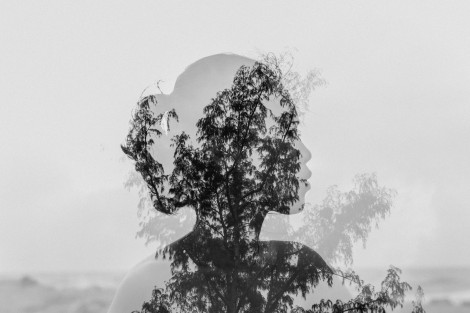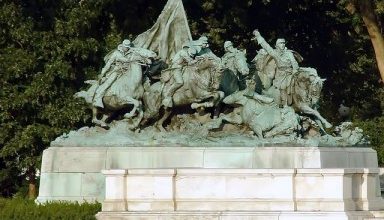
Cora, Auntie by Paula Meehan is an exploration of the strong bond that women share through space and time, finding a source of resilience through the community one is a part of. The narrator is searching for the past of her auntie Cora who passed away while fighting bravely. This search is conducted through the smallest of material things left behind, and the poet traces a history of fortitude that would soon turn to dust. The effect of memory on the lives of people, especially women, is quietly inspected using a mythical tone.
Cora, Auntie | Analysis, Lines 1 – 3
Staring Death down
with a bottle of morphine in one hand,
a bottle of Jameson in the other:
The poet sets the tone of the poem in the first lines by a fierce action of “staring Death down” where Death personified is no match for Cora’s vibrance and strength. The reference to morphine and alcohol suggests a dangerous mix of pain and struggle. Cora seems to be in extreme pain and even then, her resilience is evident.
Cora, Auntie | Analysis, Lines 4 -6
laughing at Death–
love unconditional keeping her just this side
of the threshold
As evident in the poem, later on, it is cancer that is plaguing her. However, unconditional love, from her family or friends, is enough to not let her go under. This represents the importance of a strong presence of love in one’s life. Cora’s fight is fueled by the love she is receiving. Death is not strong enough to pull her under when love is tethering her to the living realm.
Cora, Auntie | Analysis, Lines 5 – 10
as her body withered
and her eyes grew darker and stranger
as her hair grew back after chemo
thick and curly as when she was a girl;
always a girl in her glance
teasing Death–humour a lance
By showing that there is a certain youthfulness in Cora’s eyes, the poet makes this image even more potent, as Death is being challenged by a girl who resides in a wilting body, ravaged by time and illness. Humour is used as a lance by Cora to fight Death, the imagery of a knight and a hero is perceptible through this. There is an implicit sense of heroism in Cora’s battle, the glorification of a solitary fight with an invisible enemy.
Cora, Auntie | Analysis, Lines 11 – 13
she tilted at Death.
Scourge of Croydon tram drivers and High Street dossers
on her motorised invalid scooter
The lance, though, doesn’t give Cora any significant advantage as her enemy is all-powerful and Cora knows she won’t win.
Cora, Auntie | Analysis, Lines 14 – 16
that last year:
bearing the pain,
not crucifixion but glory
Cora’s inability to properly function does not deter her spirit from presenting a tough fight to Death. There is no resignation in Cora, not the sacrificial tone of crucifixion, but glory. Cora’s fight is a fight with dignity and glory, not a passive acceptance of her illness. This shows the terminal patients in a new, brave light. This is not a light battle and must not be taken as one.
Paula Meehan explores the voices of women who are suffering through immense pain, where often the voices filled with pain are ignored, especially those of women. The poet is attempting to carve a memorial place for such women and give them a space for recognition.
Cora, Auntie | Analysis, Lines 17 – 19
in her voice.
Old skin, bag of bones,
grinning back at the rictus of Death:
The imagery presented here is gruesome and creepy, there is suffering in the body, “old skin, bag of bones” shows the dilapidated state of Cora’s body. Cora is almost as skeletal as a dead person, as Death, but still, her smile is full of life and solidity, in direct contrast to the “rictus”, the immovable smile of Death.
Cora, Auntie | Analysis, Lines 20 – 25
always a girl in her name–
Cora, maiden, from the Greek Kopn,
promising blossom, summer, the scent of thyme.
And we would know the very moment
it was time to go and leave her
in the arms of Death who desired her so
Cora is remembered for her youthful nature and beauty, just like her name which meant Spring in Greek, full of life. The positioning of her name and the fact that Death desired her, magnifies this situation to mythical proportions as the readers are taken back to the Greek myth of Persephone and Hades, the powerful nature of trying to take the goddess of Spring to a barren underworld. Persephone’s birth name in some versions of this story is Kore, which is echoed in Cora’s name. Paula Meehan’s propensity to include mythological references in her poems is sometimes subtle, such as here.
Cora, Auntie | Analysis, Lines 26 – 31
and walk out under the stars of April
thrown like sequins
on the velvet of night.
Sequin: she is standing on the kitchen table.
She is twenty one.
It is nineteen sixty one.
This subtle shift in the tone of the poem is the poet’s attempt at presenting a turn of the direction in the story. The sequins provide the narrator with memories of the past.
Cora, Auntie | Analysis, Lines 32 – 40
The women are sewing red sequins
to the hem of her white satin dress
as she moves slowly round and round.
Sequins red as the berries,
red as the lips of maids
in old time ballads,
red as blood on the snow,
as blood on the bedsheet,
as this red pen on this white paper
The vivid imagery of these lines is accentuated by the color red which is a symbol of youth, love, and sensuality. Along with the living connotations, red is also associated with the otherworld and the unreal, which is why it is considered unlucky in many ancient Irish texts. The color red also invokes the image of blood and is thus associated with Death. The sequins in red color denote a certain finality to Cora’s life, where her youth is already reflecting her end, with red, with death. Cora is carrying the symbols of death on her.
The reference to the women sewing the sequins in Cora’s dress denotes the number of hands, of women specifically, in making Cora’s dress. This is implicitly a mention of the generations and number of women who helped shape the life of their descendant Cora, and in turn, the narrator.
Cora, Auntie | Analysis, Lines 41 – 43
I’ve snatched from the flux
to catch this poem
at my own kitchen table–
The sequins are a means of connection between past and present, that connect the narrator to Cora and the women who came before Cora, whose existence is promptly erased from history. The penning down of their stories, of Cora’s story, is an act of rebellion against the metaphorical death of the voices of the women’s ancestors. The poet means to provide a line of connection between the current generation and the older generations, through writing and carrying on the legacy.
Cora, Auntie | Analysis, Lines 44 – 50
Cora, Marie, Jacinta, my aunties,
Helena, my mother, Mary, my grandmother–
the light of those stars
only reaching me now.
I orbit the table I can barely see over.
I am under it singing.
As a child, the narrator did not understand the inherent value in her connection to her female family members and relatives. The “light of those stars” reaches the narrator only now when she is an adult. The reference to the stars denotes that even if the family members and ancestors are dead, their stories live on, in the light, they shine on the future generations, the indirect impact they have on the narrator.
Cora, Auntie | Analysis, Lines 51 – 59
She was weeks from taking the boat to England.
Dust on the mantelpiece,
dust on the cards she left behind:
a black cat swinging in a silver horseshoe,
a giant key to the door,
emblems of luck, of access.
All that year I hunted sequins:
roaming the house I found them
in cracks and crannies,
Cora is said to have emigrated to England, leaving behind some of her possessions which present a picture of her life to the narrator. There is dust everywhere, which signifies that everything must eventually turn to dust. Like Cora’s possessions, one day she will also perish.
The narrator searches and hunts for the red sequins of Cora’s dress as a way to trace Cora’s life history and recapture her memories and presence in this house. The sequins are scattered everywhere, in every nook and corner, which represent the all-enveloping presence of Cora. She is everywhere in the house.
Cora, Auntie | Analysis, Lines 60 – 65
in the pillowcase, the eiderdown,
under the stairs,
in a hole in the lino,
in a split in the sofa,
in a tear in the armchair
in the home of the shy mouse.
The list of places and things where the sequins are being found is a way to emphasize the strong and interactive existence of Cora when she lived in this place.
Cora, Auntie | Analysis, Lines 66 – 71
With odd beads and single earrings,
a broken charm bracelet, a glittering pin,
I gathered them into a tin box
which I open now in her memory–
the coinage, the sudden glamour
of an emigrant soul.
All the remnants of Cora are collected and kept in a tin box for safekeeping by the narrator. This box is the only thing that is left of Cora for the narrator and is thus a valuable possession to the narrator. These broken and useless things have no true meaning or real value but only the memories attached to them. These are the items that revive and present the youthful and glamorous time in Cora’s life, before she turned twenty-one, and before she emigrated away to England.
The value placed in these items shows that Cora’s loss is being keenly felt by the narrator.
Paula Meehan’s poem traces a connection between the familial and the feminine, weaving the lineage and bonds between the women in a family, from generation to generation. In the poem, it is not the patriarchal line that is traced, the paternal glorified, but the maternal roots are delineated. These connections and memories are preserved, rather than the more valuable monetary power that is associated with the paternal. Sequin, a short-lived, frivolous object is presented as the site of retention of memories and lived experiences.
Stars are another site for the retention of the lineage of women. Starlight transcends the spatial and chronological boundaries and provides light through the distance of millions of kilometers and millions of years. This sublime nature of stars is compared to the connection that resists oblivion and reaches future generations.
Strong, resilient, and formidable women feature prominently in the poems of Paula Meehan. Meehan is remembering her Auntie Cora’s indomitable spirit and unflinching humor in the face of death and connects her to all the other women in their family who helped shape the poet’s life. The poem, then, transforms into a space for the remembrance, recollection, and revival of this feminine kinship.
Cora, Auntie | ABOUT THE AUTHOR
Paula Meehan was born and reared in the north inner city of Dublin. She was educated at Trinity College, Dublin, and received an MFA degree from Eastern Washington University. She has published five collections of poetry and numerous stage and radio plays. She has been the recipient of many awards, among them the Butler Award for Poetry from the Irish American Cultural Institute, the Marten Toonder Award for Literature, and the Denis Devlin Memorial Award for her most recent collection of poems, Dharmakaya (Wake Forest University Press). She is a member of Aosdána, the Irish Academy for the Arts, and teaches in a project for stabilized drug users and in other community contexts. A fine-art edition of new work (with Theo Dorgan and Tony Curtis) is forthcoming from Brooding Heron Press (located on Waldron Island in the San Juan Islands of Washington State).


